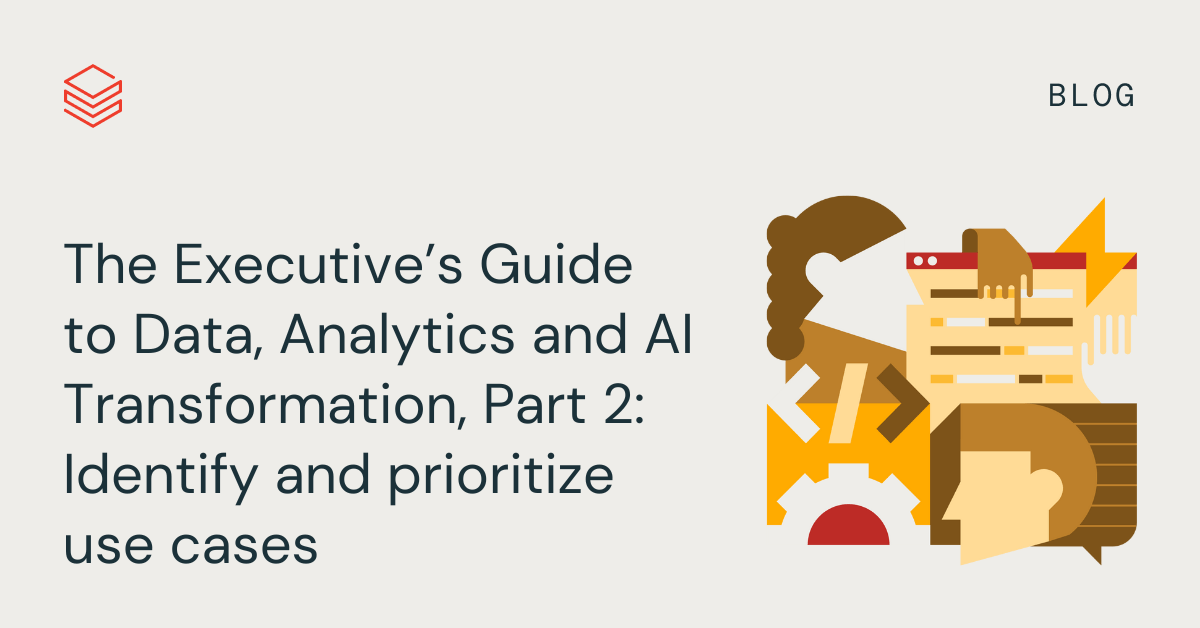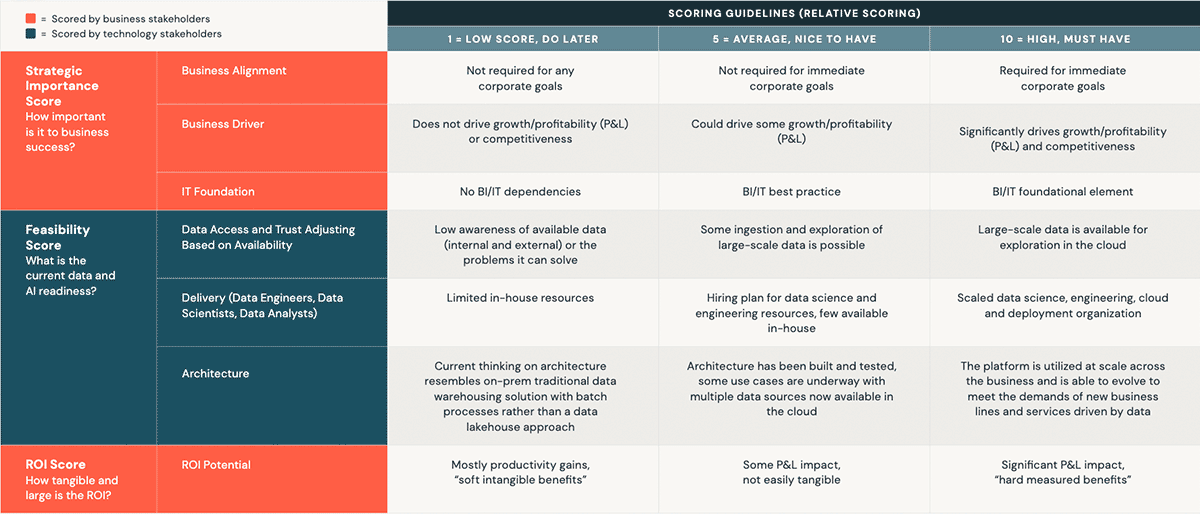The Executive’s Guide to Data, Analytics and AI Transformation, Part 2: Identify and prioritize use cases

This is part two of a multi-part series to share key insights and tactics with Senior Executives leading data and AI transformation initiatives. You can read part one of the series here.
An important step in enabling data, analytics and AI to transform your business is to identify use cases that drive business value — while prioritizing the ones that are achievable under the current conditions (people, processes, data and infrastructure). There are typically hundreds of use cases within an organization that could benefit from better data and AI, but not all use cases are of equal importance or feasibility. Leaders require a systematic approach for identifying, evaluating, prioritizing and implementing use cases.
Establish the list of potential use cases
The first step is to ideate by bringing together various stakeholders from across the organization and understand the overall business drivers — especially those that are monitored by the CEO and board of directors. The second step is to identify use case opportunities in collaboration with business stakeholders and understand the business processes and data required to implement the use case. Next, prioritize these cases by calculating the expected ROI. To avoid this becoming a pet project within the data/IT teams, it's important to have a line of business champion at the executive level.
There needs to be a balance between use cases that are complex and ones that are considered low-hanging fruit. For example, determining if a web visitor is an existing or net new customer requires a fairly straightforward algorithm that uses web browser cookie data and the correlation of the devices used by a given individual or household. However, developing a sophisticated credit card fraud model that takes into account geospatial, temporal, merchant and customer-purchasing behavior requires a broader set of data to perform the analytics.
In terms of performance, thought should be given to the speed at which the use case must execute. In general, the greater the performance, the higher the cost. Therefore, it's worth considering grouping use cases into three categories:
- Sub-second response
- Multi-second response
- Multi-minute response
Being pragmatic about the true service level agreement (SLA) will save time and money by avoiding over-engineering the design and infrastructure.
Thinking in terms of "data assets"
Machine learning algorithms require data — data that is readily available, of high quality and relevant — to perform experiments, train models, and then execute the model when it is deployed to production. The quality and veracity of the data used to perform these machine learning steps are key to deploying models into production that produce a tangible ROI.
It is critical to understand what steps are needed in order to make the data available for a given use case. One point to consider is to prioritize use cases that make use of similar or adjacent data. If your engineering teams need to perform work to make data available for one use case, then look for opportunities to have the engineers do incremental work in order to surface data for adjacent use cases.
Mature data and AI companies embrace the concept of "data assets" or "data products" to indicate the importance of adopting a design strategy and data asset roadmap for the organization. Taking this approach helps stakeholders avoid fit-for-purpose data sets that drive only a single use case — and raise the level of thinking to focus on data assets that can fuel many more business functions. The "data asset" roadmap helps data source owners understand the priority and complexity of the data assets that need to be created. Using this approach, data becomes part of the fabric of the company, evolves the culture, and influences the design of business applications and other systems within the organization.
Determine the highest impact/priority
As shown in the table below, organizations can evaluate a given use case using a scorecard approach that takes into account three factors: strategic importance, feasibility and tangible ROI. Strategic importance measures whether or not the use case helps meet immediate corporate goals and has the potential to drive growth or reduce risk. Feasibility measures whether or not the organization has the data and IT infrastructure, plus the data science talent readily available, to implement the use case. The ROI score indicates whether or not the organization can easily measure the impact on P&L.

Ensure business and technology leadership alignment
Prioritizing use cases requires striking a balance between offensive- and defensive-oriented use cases. It is important for executives to evaluate use cases in terms of opportunity growth (offensive) and risk reduction (defensive). For example, data governance and compliance use cases should take priority over offensive-oriented use cases when the cost of a data breach or noncompliance is higher than the acquisition of a new customer. In order to ensure the successful delivery and impact of use cases, technology stakeholders must work closely with business leaders to align on corporate goals and strategic priorities.
Conclusion
Whether you are just getting started or already on a data and AI transformation journey, these strategies can be applied to identify and prioritize use cases and drive business value. To accelerate the delivery of high-impact use cases, Databricks provides a library of industry-focused Solution Accelerators. To learn more, please contact us.
Want to learn more? Check out our eBook Transform and Scale Your Organization With Data and AI.

The C-suite dialogue on generative AI
Industry experts reveal winning strategies that minimize risk.

